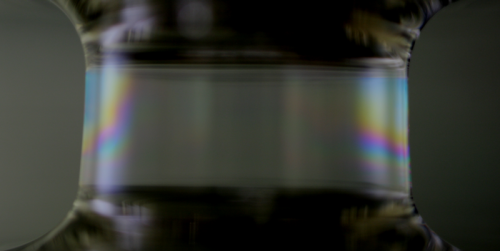
The image above comes from an experiment conducted by Anne-Luare Biance and her colleagues at the University of Lyon (France), who set out to investigate the effect of electric fields on soap films. They trapped a bubble between two platinum electrodes and turned up the voltage. Doing this, they discovered, thickened the film which, in turn, increased the rate of flow between the plates.
The thicker walls allowed the bubble to last for hours on end, even changing colors as the walls got denser.
The video below shows the thicker bubble with electricity running through it:
The following video shows two bubbles, set up side by side, with electricity running through them:
Given that soap is just a few nanometers thick, Ms. Biance and her colleagues believe that this phenomenon could be useful in the future of microfluidic systems.
“The interest is that this device would be low cost, with its properties mainly due to the deformability of the channel,” Biance says. The team is also interested in seeing if electric fields could be used to stabilize foams, which tend to collapse when water drains out of them due to gravity.
Brown University’s Derek Stein is equally as excited by this discovery: “[This work] breaks new ground by removing the solid walls that usually define the geometry of a nanofluidic system and control many of its important characteristics.” He adds that soap films could eventually answer questions about motion at the fluid-wall interface. “By simply changing the soap used to make the bubble, it should also be possible to tune the surface charge density, the surface tension, or other important physical parameters.”
The group’s work was published under the title, “Soft Nanofluidic Transport in a Soap Film” in Physics Review Letters. It is available for purchase.
Share your thoughts on this new technology in the power solutions community on DigiKey’s TechXchange.
Story via: physics.aps.org
Advertisement





